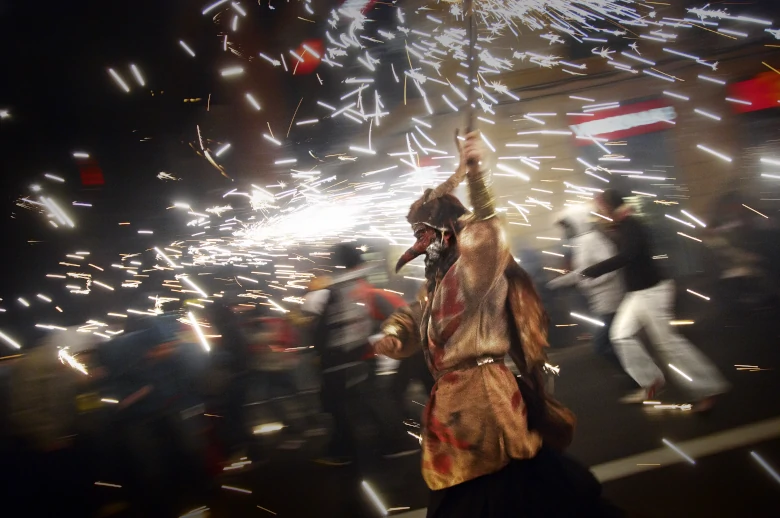
The dimonis are the real stars of the correfocs of Sa Pobla. Photo: Mateu Bennàssar © Arxiu AETIB.
Mallorca’s village fires i festes are much more than just festive events; they are a vibrant celebration of the island’s identity and cultural diversity. From music and dance to crafts and gastronomy, these festivities are a living testimony to Mallorca’s rich heritage. They feature emblematic figures such as dimonis, gegants and caparrots, who entertain and embellish the celebrations with their imposing and colourful presence. If the fires i festes are the heart of Mallorca, they mark the rhythm of its heartbeat. Join us on this exciting journey with Mallorca Caprice where you will discover the most representative figures of Mallorcan folklore!
Dimonis
The dimonis (devils) are fundamental figures in Mallorca’s festivities, symbolising the struggle between good and evil and bringing an element of mystery and excitement to the celebrations. With their diabolical costumes and masks, these disturbing characters represent dark forces that are believed to ward off evil and purify the atmosphere, becoming the protagonists of events full of energy and tradition.
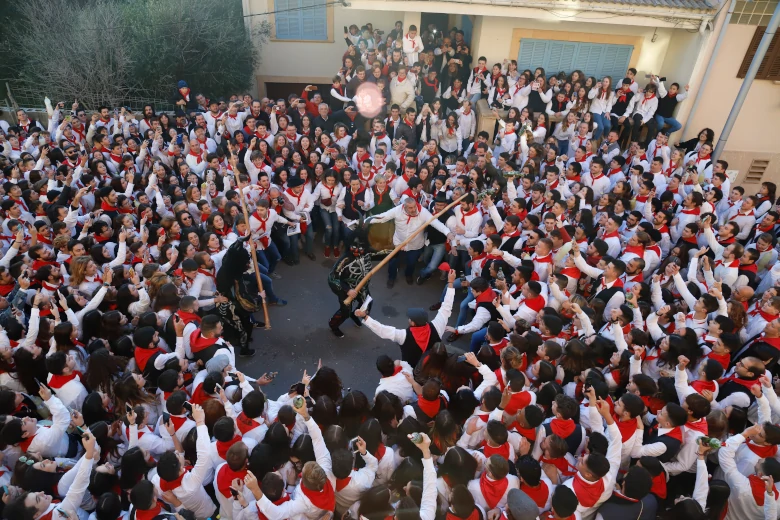
The dimoni of Artà is a central figure in the festivities of Sant Antoni. Photo: Teresa Ayuga.
One of the most eagerly anticipated moments of many festivals is the correfoc, where the dimonis parade through the streets amidst fireworks and flares. This pyrotechnic spectacle, characterised by the close interaction of the audience with the fire, creates an electrifying and visually striking atmosphere. The dimonis, with their torches and choreographed movements, lead these fire parades, dancing to the rhythm of drums and creating a captivating show.
In addition to the correfocs, the dimonis take part in other fire performances, manipulating torches and performing acrobatics that keep the audience on edge. Their presence at these festivities not only adds drama and entertainment but also keeps an ancestral tradition alive. The dimonis, with their energy and symbolism, are an essential part of the Mallorcan folklore.
¿Did you know…?
One of the most iconic dimonis of Mallorca is the one from the town of Artà, a central figure in the Sant Antoni festivities. An attire of this dimoni, dating from 1920, has been on display at the Museo del Traje in Madrid since 1975 due to the uniqueness of its heavy mask and its spectacular outfit: a black cotton taffeta suit painted with oil, decorated with serpents or asps that coil around the body, arms, and legs.
Gegants
The gegants (giants) are impressive figures and constitute a unique blend of history, culture, and folk art. These articulated statues can reach several metres in height, creating an effect of nobility and grandeur during their appearances at Mallorca’s festivals. They represent emblematic characters from local tradition, ranging from historical figures to popular archetypes, and typically parade in pairs of male and female figures.
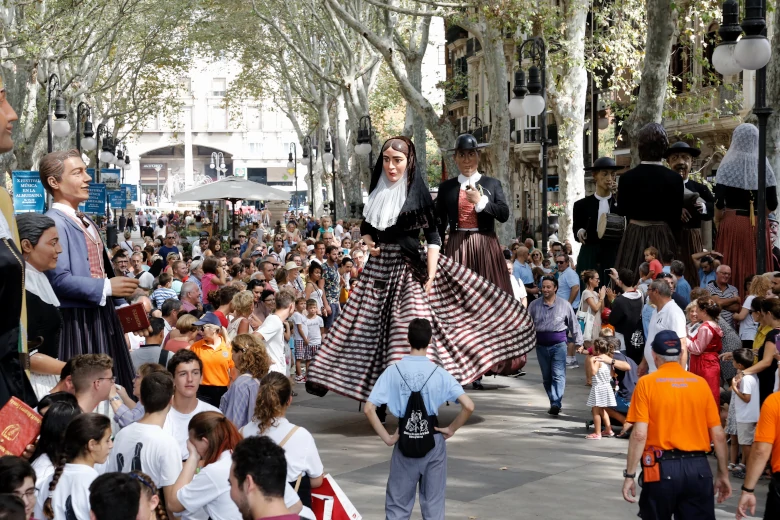
The gegants of Palma dance in the Passeig del Born. Photo: Teresa Ayuga.
Crafted from materials such as papier-mâché, polyester, or fibreglass, and mounted on sturdy wooden or metal frames, the giants parade and dance majestically through the streets to the rhythm of festive music, dressed in elaborate costumes. Each giant is not only a work of art in itself, with meticulous details and vibrant colours that make them stand out in the parades, but also a symbol of Mallorcan identity.
The earliest documented references to the presence of gegants on the island date back to 1630 in the town of Sóller. Originally part of the Corpus Christi celebrations, their religious function gradually faded, evolving into a popular icon and guardians of Mallorca’s tradition and history.
¿Did you know…?
The longest-standing gegant not only in Mallorca but across all of the Balearic Islands is En Vicenç de Manacor. This imposing figure, standing 3.80 metres tall and weighing 50 kilograms, was restored in 1942 when he was named in honour of Sant Vicenç Ferrer and received his distinctive medieval-style attire, complete with a large cape and a yellow headscarf. En Vicenç always parades and dances alongside Na Catalina, his inseparable companion.
Caparrots o capgrossos
The caparrots or capgrossos (big-heads) are an essential part of Mallorcan festivals, adding a touch of joy and fun to local celebrations. These figures, with their large heads and colourful costumes, represent historical, folkloric, and caricatured characters, providing a comic counterpoint to the solemnity of the gegants. The caparrots parade through the streets, interacting with the public, especially children, who enthusiastically chase them with delight.
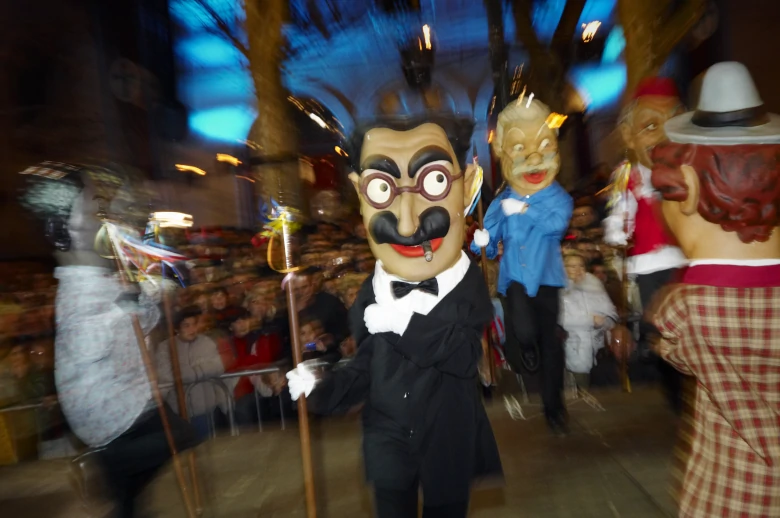
Groucho Marx is the most emblematic caparrot of Sa Pobla. Photo: Mateu Bennàssar © Arxiu AETIB.
These emblematic characters, once made of papier-mâché and now crafted from polyester or fibreglass, enliven the festive atmosphere with their presence, swaying to the rhythm of traditional music and making spectators laugh with their exaggerated movements and playful jokes. Each figure has its own personality and style, adding diversity and richness to the celebrations.
The big-heads not only provide entertainment but also keep alive a tradition passed down through generations. Their introduction to the island dates back to around the 17th century, though they gradually fell into disuse. It wasn’t until the first half of the 20th century that the caparrots regained a relevance that continues to this day.
¿Did you know…?
In 1952, the colla de caparrots (big-heads group) of Sa Pobla was established, boosting this tradition across the island. For its creation, comic personalities of the time were chosen, which was a novel approach, including the famous clown Charlie Rivel and the Marx Brothers: Harpo, Chico, and especially Groucho Marx, who has his own dance and is well-known throughout Mallorca.
Cossiers
The cossiers represent one of the island’s oldest and most deeply rooted traditions, first documented in Mallorca in 1554. These dancers, typically consisting of six men (though the number can vary) and a lady (who may be played by either a man or a woman), wear costumes adorned with ribbons and brightly coloured flowers, along with a straw hat.
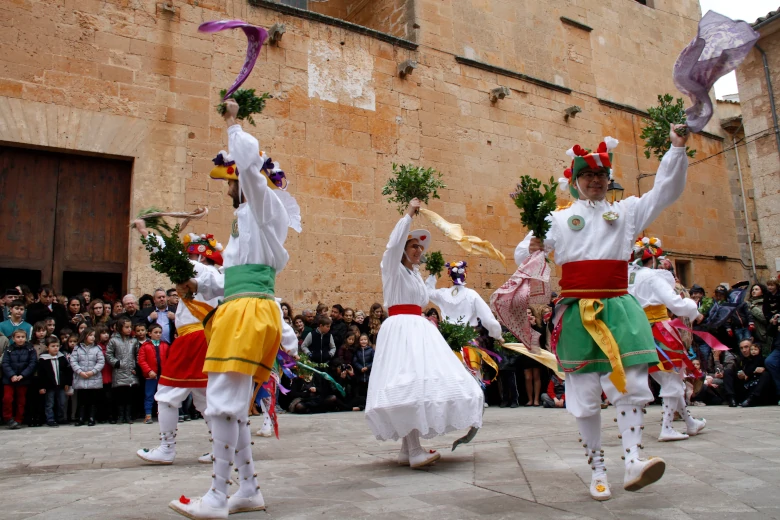
The dance of the cossiers in Montuïri is declared a Festival of Cultural Interest. Photo: Teresa Ayuga.
The dance of the cossiers is a combination of ritual and acrobatic movements symbolising the struggle between good and evil. The figure of the lady represents purity and good, and is protected by the cossiers, who form a circle around her to guard against the dimoni, a grotesque character embodying evil. Their dances, rich in symbolism and tradition, connect the community with its historical and spiritual roots.
The performances of the cossiers are especially prominent in the towns of Alaró, Montuïri, and Manacor, recognised as Festivals of Cultural Interest. However, the dance is also performed in municipalities such as Algaida, Inca, Pollença, and in the Palma neighbourhood of Son Sardina, among other places on the island.
Did you know…?
Traditionally, the figure of the lady was played by a man. However, over the years, the role of the lady has increasingly been taken on by a woman. The group from the Son Sardina neighbourhood in Palma, which first performed on Corpus Christi in 1981, is unique in that it is the only one composed entirely of women, with only the figure of the dimoni being played by a man.
Moros i cristians
The Moros i cristians (Moors and cristians) festivities commemorate the historic confrontations between Christian and Muslim forces in Mallorca. These events recreate the battles and skirmishes that shaped the island’s history, celebrating events such as the conquest by Jaume I of Aragon in Calvià or the defense against Turkish attacks during the 16th century in towns like Sóller, Pollença, and Andratx.
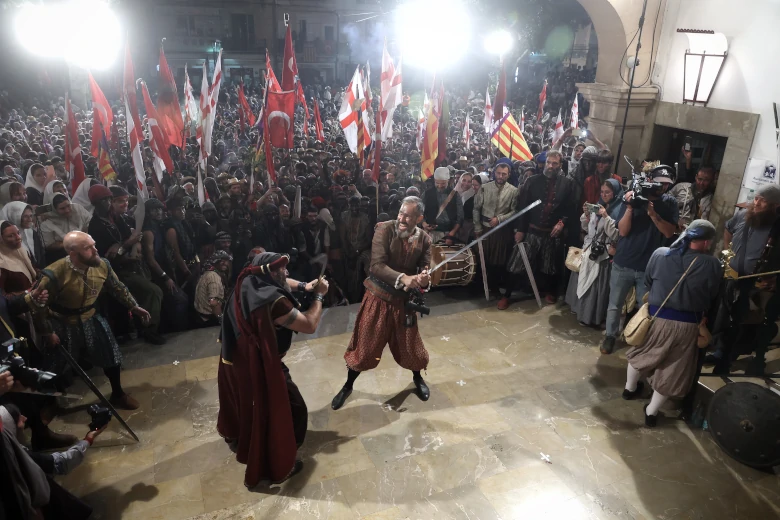
The fiestas de Moros i cristians in Sóller attract thousands of people each year. Photo: Teresa Ayuga.
During these spectacular and eagerly anticipated festivities, the streets come alive with colour and music from large and lively parades. The processions feature groups dressed in elaborate period costumes that proudly represent both sides of the historic conflict. Participants, adorned with armour and swords or farming tools and shirts on one side, and turbans, tunics, and scimitars on the other, march to the rhythm of bands and drums, creating an unparalleled atmosphere.
The most eagerly awaited moments are the theatrical representations of the battles, culminating in the Christian victory, symbolising local resistance and triumph. Thanks to these festivals, names such as the Pollencí Joan Mas, the pirate Dragut, the Capità Angelats, and the Valentes Dones de Sóller will never be forgotten.
Did you know…?
The feared Turkish pirates often carried scimitars, curved swords that resemble a crescent moon, while the Christians used cross-shaped swords. The scimitars allowed them to cut their opponent in the same motion as drawing the blade, providing them with a tactical advantage in combat.
Xeremiers
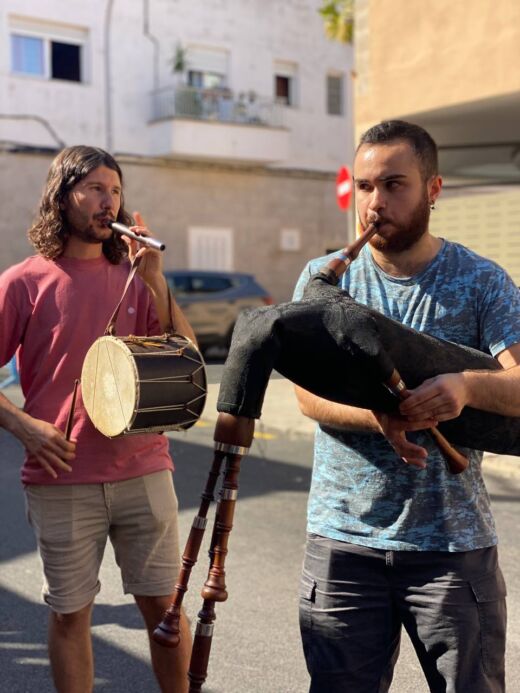
Image of the colla Xeremiers des Prat during a performance. Photo: xeremiersdesprat@gmail.com.
The xeremiers provide the distinctive sound of Mallorcan festivals. With roots tracing back to the Middle Ages, the xeremiers have been the guardians of a musical tradition passed down through generations. Their music accompanies the ball de bot, the gegants, caparrots, cossiers, and dimonis in both public and private celebrations, synchronising movements and adding a sense of cohesion to the festivities.
In Mallorca, the colla de xeremiers (group of musicians) consists of a xeremier, who plays a traditional Mallorcan bagpipe called the xeremia, and a flabioler, who plays both the flabiol (a one-handed flute) and the tamborino (a small wooden drum worn on the same hand). The repertoire ranges from traditional processional tunes and corregudes (played at each town’s festivities) to boleros, jotas, and copeos, as well as newly created pieces.
The cheerful sound of the xeremies and flabiol and the steady beat of the tamborino are undoubtedly fundamental elements of the island’s celebrations. Hence, the xeremiers have the motto “Cap festa sense xeremies!” (no party without xeremies).
Did you know…?
The xeremies have several wooden parts, including the bufador (where the air is introduced), the grall (which produces the musical notes), and the bordons (which provide the continuous sound or pedal note). Tradition says that to prevent the wood from rotting, it should be cut in February under a waning moon from a deciduous tree, or in November under a new moon if the tree is evergreen.
La Sibil·la
Originating in the 10th century and rooted in the ancient Greek and Roman sibil·les (prophetesses), the Cant de la Sibil·la is a solemn and foreboding medieval chant performed during the Midnight Mass on Christmas Eve on the island. This poem, recited in Latin or Mallorcan, is performed by a soprano, formerly a child, dressed in a robe and holding a sword in front of her face, culminating in the formation of a cross at the end of the chant.
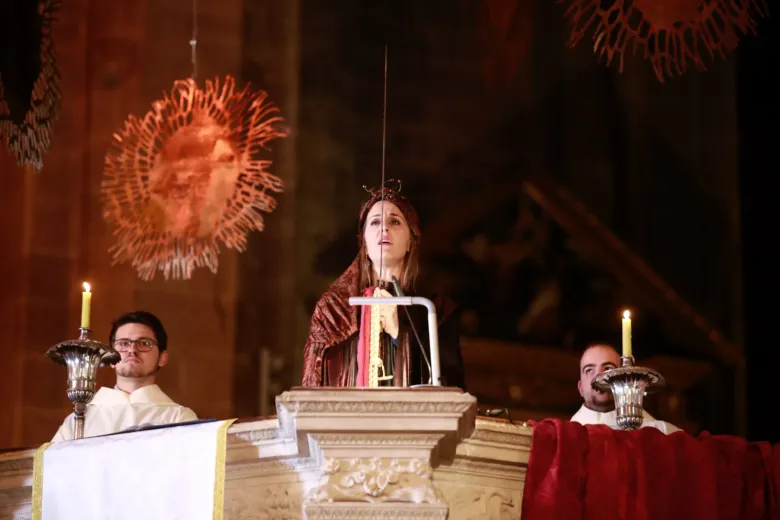
The Cant de la Sibil·la at Palma Cathedral. Photo: Teresa Ayuga.
The Cant de la Sibil·la is a dramatic representation warning about the Last Judgment and the separation between the righteous, who will be welcomed by God, and the sinners, who are destined for hell and its torments. The lyrics describe the final cataclysm, with images of stars falling from the sky and the prophesied arrival of the Messiah. Recognised as Intangible Cultural Heritage by UNESCO since 2010, this tradition underscores its deep connection with Mallorca’s cultural and spiritual roots, being passed down through generations as an integral and highly anticipated part of the Christmas festivities.
Did you know…?
The Council of Trent (1545-1563) banned the Cant de la Sibil·la, due to its pagan origins, to prevent local practices that might deviate from the official teachings of the Church. However, due to its strong cultural roots in Mallorca and Alghero (Sardinia), it continued to be performed clandestinely until it was officially revived in the 1960s.
Bèsties de foc
The bèsties de foc (fire beasts) are impressive, giant, and colourful figures that represent mythical creatures such as dragons, horses, and other fantastic entities. These enormous structures, made from lightweight yet durable materials to facilitate their movement, parade through the streets of towns and cities accompanied by fireworks, pyrotechnics, and deafening music, creating an unparalleled display of light and sound.
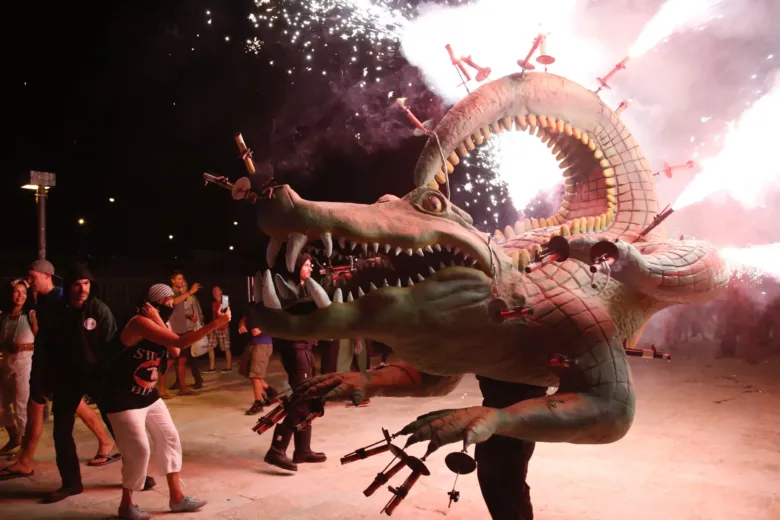
The Drac de Na Coca parading through the streets of Palma. Photo: Teresa Ayuga.
One of the most famous is the Drac de Na Coca (Dragon of Na Coca), which has been a central figure in the festivities of Sant Sebastià and Sant Joan in Palma since 2011. Its creation is linked to an intriguing legend. In 1776, a rumour spread that a great dragon was prowling around La Portella street, near the Cathedral. Neighbours reported strange night-time noises and claimed that the beast had devoured children and beggars. The knight Bartomeu Coch, on his way to his fiancée’s house (hence the name Drac de Na Coca), confronted and killed the feared reptile. It was later discovered that the “dragon” was actually a crocodile that had grown in the sewers. The Drac de Na Coca weighs 50 kilos, stands 1.80 metres tall, and measures 1.83 metres in width, with 7 points of fire.
Did you know…?
The crocodile, having been embalmed due to its uniqueness, has been displayed at the Museu Diocesà de Palma since the early 20th century, donated by the Coch family. Additionally, a sculpture of the reptile adorns the walls of the building opposite the museum. Can you spot it?
Cavallets
The cavallets (little horses), with origins dating back to the 15th century, can be enjoyed in towns such as Pollença, Artà, Felanitx, Llucmajor, Palma, and Calvià. These figures, true stars of various festivals like Sant Joan, Sant Sebastià, and Sant Agustí, are primarily made of wood or papier-mâché and are carved and painted to resemble horses. They are then adorned with colourful fabrics, ribbons, and other decorations, such as tails and manes made of rope or thread, adding detail and realism while reflecting the care and affection with which this element of Mallorcan folklore is preserved.
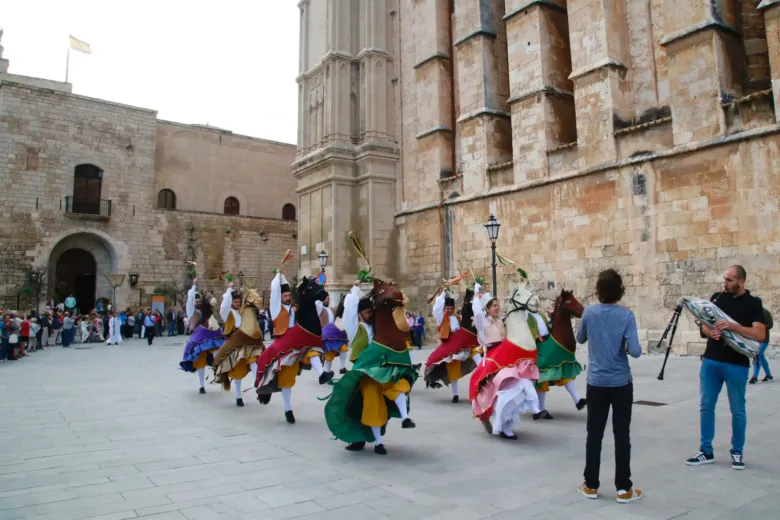
The Cavallets dancing in front of Palma Cathedral. Photo: Teresa Ayuga.
These structures are carried at waist height by children or adults dressed as riders, who, with a distinctive rhythm, mimic the gallop and dances of the horses. This lively and animated choreography is usually accompanied by music from the xeremia, flabiol, and tamborino, creating a festive and infectious atmosphere.
A blend of pagan tradition and Christian celebrations, the cavallets reflect Mallorca’s rich cultural history and symbolise the island’s connection to nature and animals, highlighting the importance of the horse in the island’s history and economy.
Did you know…?
Pollença is the only town in Mallorca that preserves the unique Dansa de les Àguiles i Sant Joan Pelós (Dance of the Eagles and Hairy Saint John), a ritual dance from Corpus Christi. Similar to the cavallets, it features two girls inside cardboard eagles, lavishly decorated with jewellery lent for the occasion by the townspeople.
Pagesos i pageses
The pagesos (farmers) and pageses (female farmers) occupy a central place in Mallorcan tradition, symbolising the island’s deep connection to its agricultural and rural past. Men, or pagesos, typically wear white shirts, vests, sashes, calçons amb bufes (wide trousers), stockings, and espardenyes (canvas and esparto shoes). Women, or pageses, dress in white rebosillos or volants (head and shoulder scarves), gipons (fitted black bodices), calçons (petticoats), wide and colourful skirts, aprons, and esparto shoes laced over their stockings. These traditional garments illustrate Mallorca’s identity and essence.
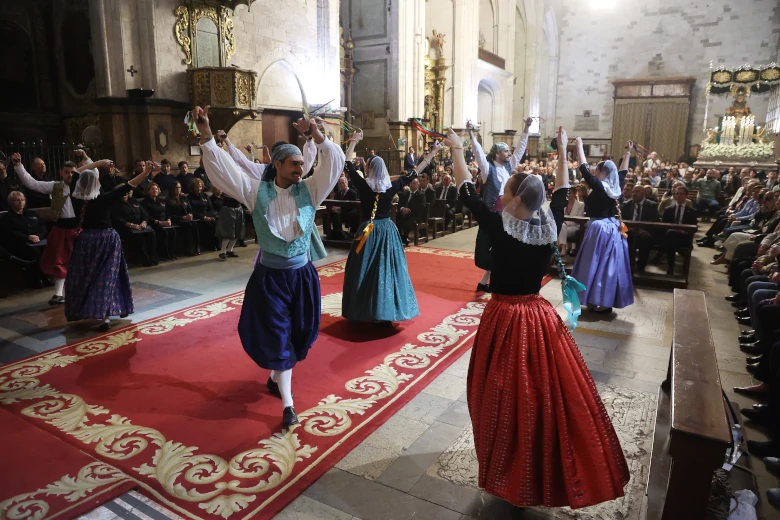 Pagesos i pageses performing one of their traditional dances. Photo: Teresa Ayuga.
Pagesos i pageses performing one of their traditional dances. Photo: Teresa Ayuga.
Specifically, the pagesos and pageses are central to the ball de bot (jumping dance), a collection of traditional dances rooted in rural festivities that includes the jota, fandango, and bolero. The name reflects the dynamic and energetic nature of these dances. The steps of the ball de bot are varied and can include jumps, turns, and acrobatics, requiring agility and coordination from the dancers. Men and women perform synchronized movements, often holding hands while dancing in circles or lines, adding an element of harmony, camaraderie, and celebration.
Did you know…?
The gipó is traditionally black due to mourning, a custom strictly observed by devout Mallorcan women in the 19th century, as they often had a deceased loved one to whom this colour could be dedicated due to the high mortality rate of the time.

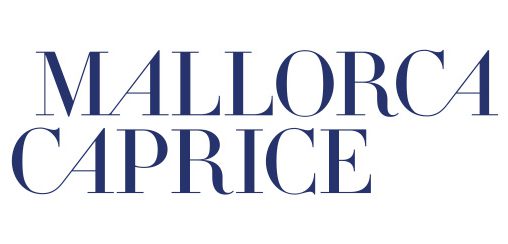
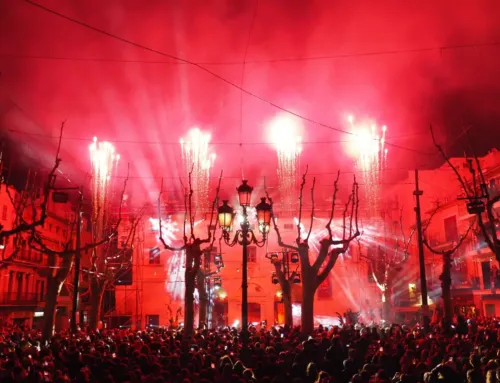
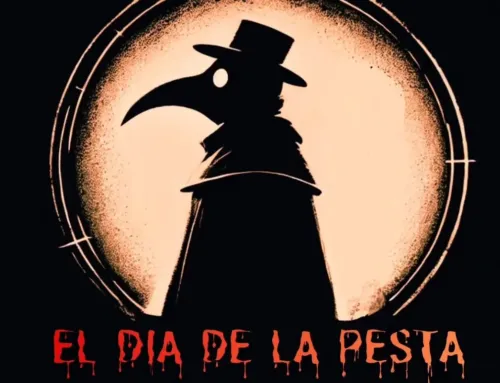
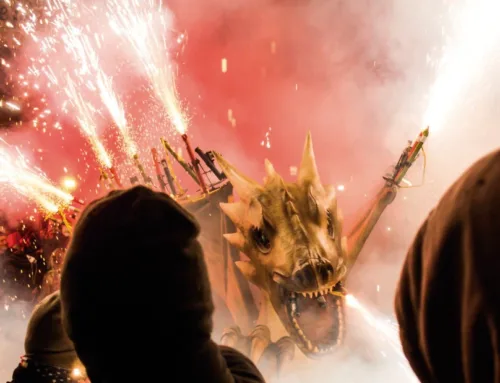
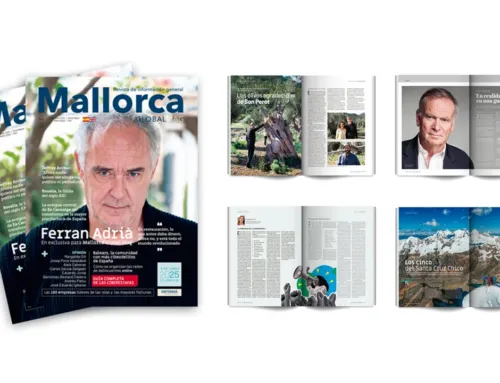


Leave A Comment